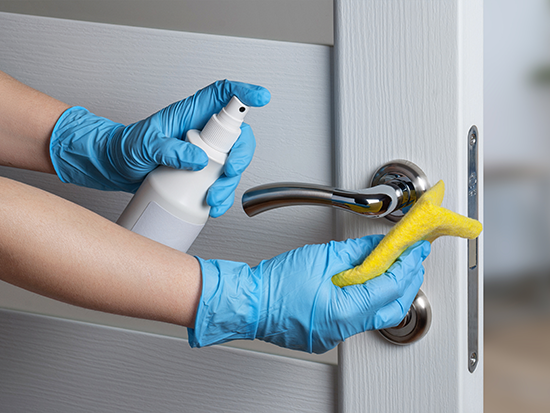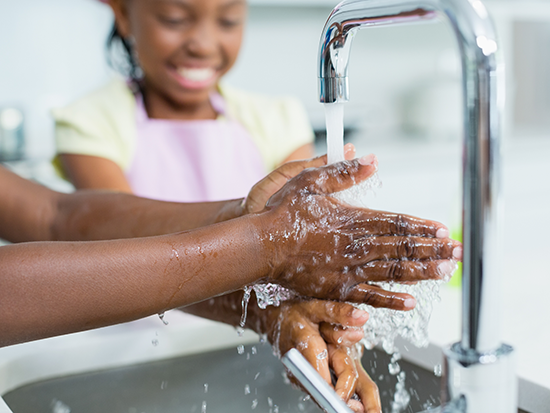 Cleaning commonly touched surfaces with soap and water and disinfectant sprays can kill germs and lower chances of becoming infected.Back-to-school time brings an excitement for new classes, a new year and new opportunities. However, it can also bring an increase in illnesses for kids, teachers and parents.
Cleaning commonly touched surfaces with soap and water and disinfectant sprays can kill germs and lower chances of becoming infected.Back-to-school time brings an excitement for new classes, a new year and new opportunities. However, it can also bring an increase in illnesses for kids, teachers and parents.
“When kids return to school, they are suddenly in close contact with many students who are outside of their summer social circle and could be exposed to new germs, which can lead to an increase in illnesses like the common cold,” said Suzanne Judd, Ph.D., chair of the University of Alabama at Birmingham Department of Health Behavior. “Kids can then bring germs home to their parents and family, who can inadvertently take those germs to the workplace.”
This time of year makes homes, classrooms and workplaces breeding grounds for germs and bacteria. Judd discusses ways to limit the spread in these places to protect your friends, family and co-workers.
Start at home
“You cannot germ-proof your home, but you can clean and disinfect things to improve chances of preventing the spread of illnesses,” Judd said.
Cleaning commonly touched surfaces with soap and water and disinfectant sprays can kill germs and lower chances of becoming infected. The biggest germ sources in the home are surfaces such as countertops, doorknobs, computer keyboards, toys, phones and faucet handles.
If someone is sick, Judd advises to avoid sharing items such as cups and glasses, silverware, and towels with them.
“If it is possible, choose a bathroom for the sick person to use and their own bedroom to sleep in, and plan to clean these rooms daily,” Judd said. “Frequently washing your hands and having disposable facemasks, especially for house members with medical conditions, are also good preventive measures.”
Educate children in the classroom
Teaching children about germs, bacteria and other contagious diseases starts at home but should continue at school as well. Children spend most of their day at school or day care, and they need to be healthy and present to succeed in the classroom.
In classrooms, educators should take charge of teaching cleanliness and disinfecting techniques. Some activities include:
- Sing “If You Are Happy and You Know It, Scrub Your Hands” while washing your hands to ensure that students wash for the appropriate amount of time.
- Model how to wash your hands with the appropriate amount of soap.
- Cough or sneeze into their elbow/sleeve if tissues are not available.
- Simulate how germs spread by using a drop of unscented lotion and a pinch of glitter. Make a fist with glitter in it, then open the hand to show how glitter spreads. The teacher touches another child’s hand to show how the glitter spreads easily. Use a paper towel to wipe off the glitter. The glitter is hard to get off, showing how easily germs spread from person to person.
 Singing “If You Are Happy and You Know It, Scrub Your Hands” while washing your hands can ensure that students wash for the appropriate amount of time.Parents can also contribute to promoting keeping germs out of the classrooms by:
Singing “If You Are Happy and You Know It, Scrub Your Hands” while washing your hands can ensure that students wash for the appropriate amount of time.Parents can also contribute to promoting keeping germs out of the classrooms by:
-
Sending hand sanitizer, paper towels, tissues and disinfectants to help keep the classroom clean.
-
Keeping the child at home if they are running a fever, coughing or sneezing excessively or if they are lethargic. If symptoms persist, call your pediatrician.
-
Teaching children proper handwashing techniques by supervising them for the first few times.
-
Exemplify cleaning behaviors by keeping your home organized and disinfected.
Keep it clean at work
Similar to infection prevent at home, Judd says following simple hygiene rules in the workplace can keep yourself and co-workers safe:
- Stay home if you are not feeling well.
- Wash hands frequently.
- Sanitize hands often.
- Reconsider eating together if you or one of your colleagues has cold symptoms.
- Minimize close contact such as shaking hands and giving hugs.
- Have cleaning supplies such as disinfectant wipes and sanitizers readily available.